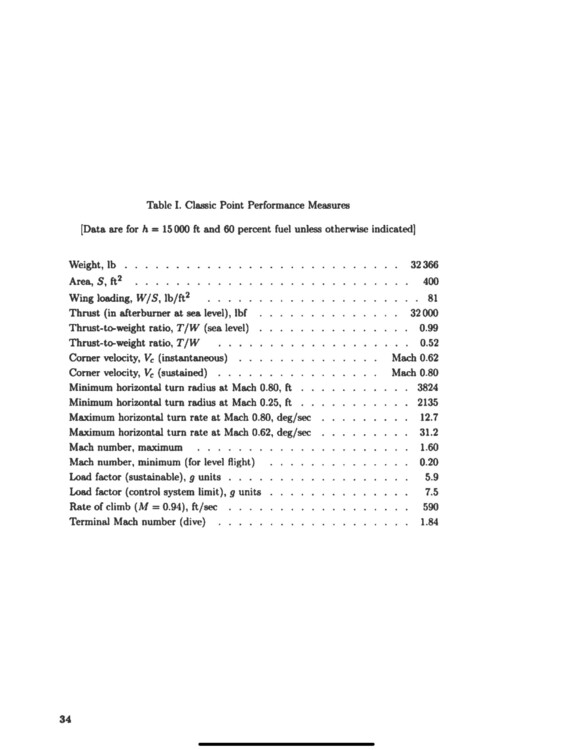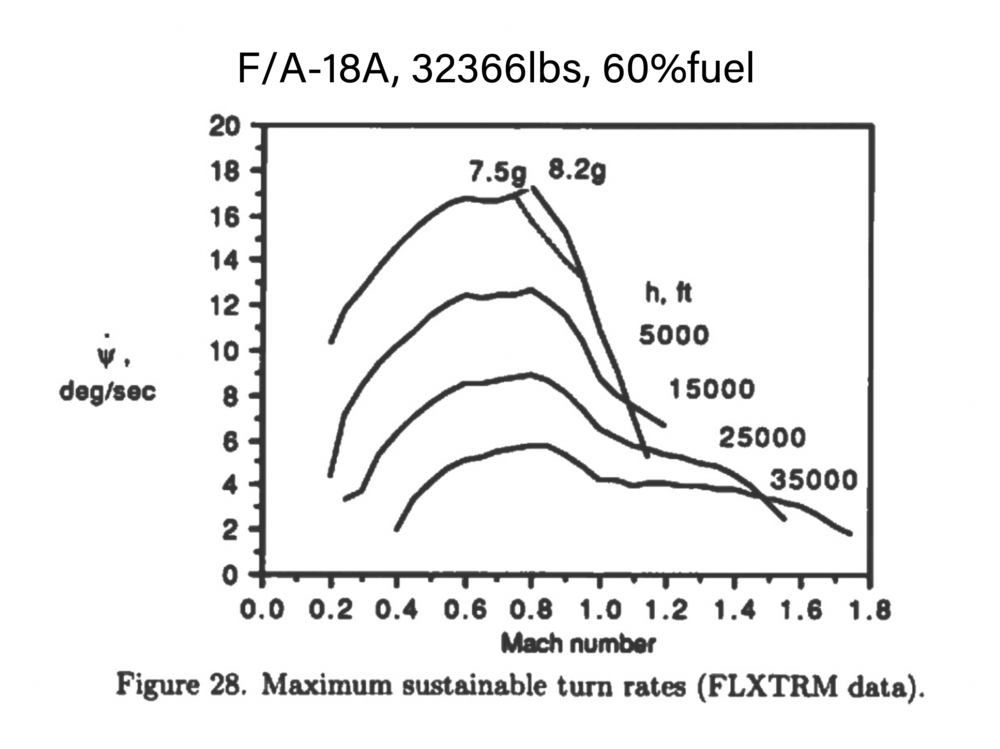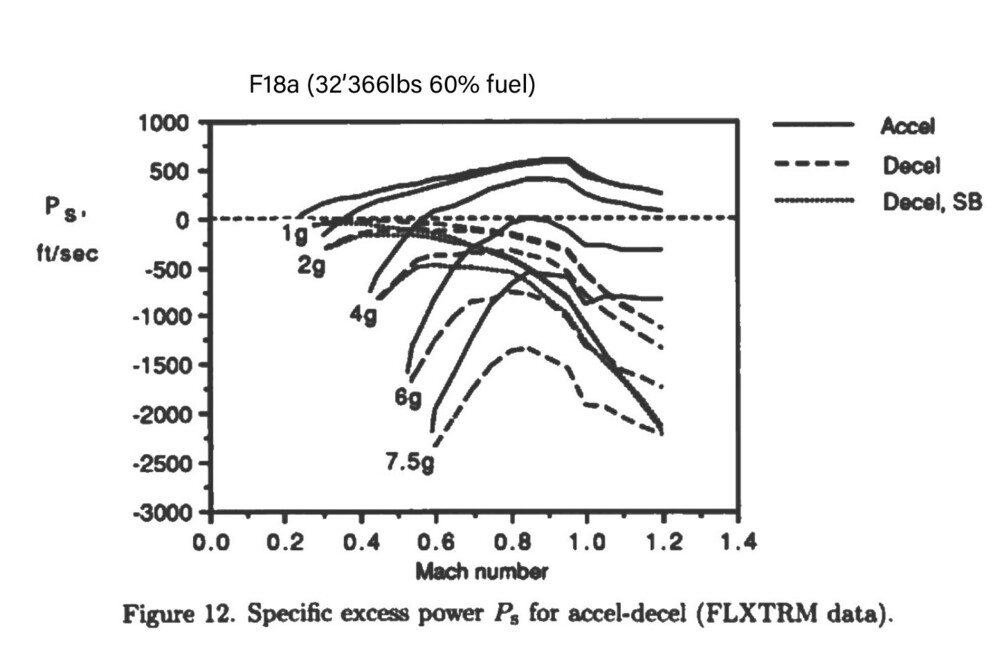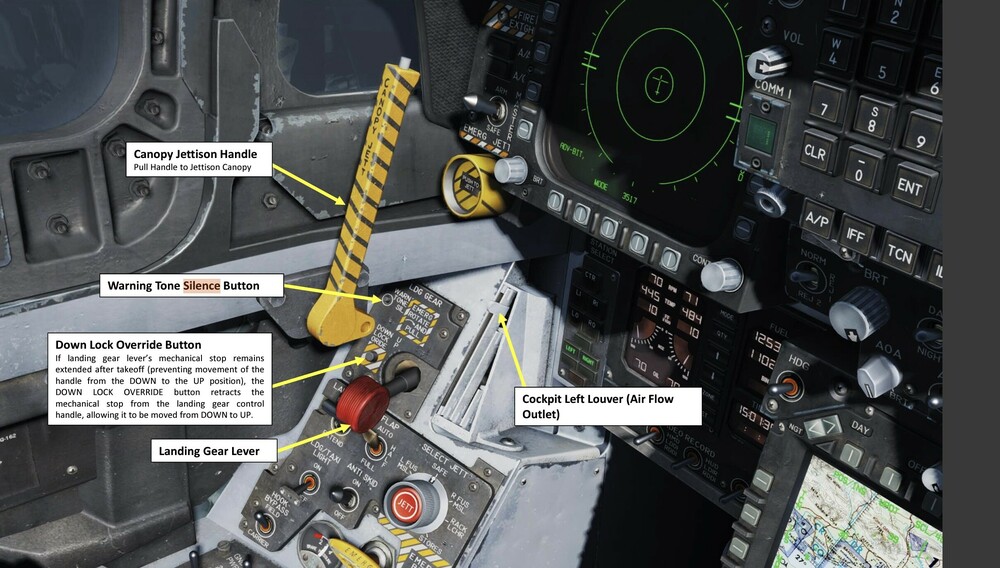-
Posts
127 -
Joined
-
Last visited
Personal Information
-
Flight Simulators
FSX
DCS
Falcon af
Janes F-18 -
Location
CH
Recent Profile Visitors
The recent visitors block is disabled and is not being shown to other users.
-
You are right of corse and sure enough, that‘s how the ed f-18 works in game. Try that: jump in a edf18 (33325lbs, 2 aim9, 2 a120, standard atmosphere) at sea level and accelerate in full burner to max sustainable speed (which is ~ M 1.13). Then start a max g-pull in full ab (do not paddle, so 7.3g) and watch your air speed. Keep pulling until airspeed stays constant (which will be ~ M 1.01). Str at M 1.01 will therefore be ~11.8°/s , 7.3g. Now keep turning and pull the paddle. Watch the speed decrease again. You will see, str now is 16.3°/s @ M0.95 (9.4g). You can do the test of corse while accelerating too. Accelerate to M0.86 and pull 9.4g. Your wings will ripp off soon… lol. It will work tho if you start your pull at M0.93. Our hornet sustains 9.4g (+) between ~M0.83 and ~M0.95. The str at M0.83 is of corse much higher than at M0.95…. Edit: By the way, i get a str of 19.3°/s at M0.62 (7.3g) and 19.4°/s at M0.83 (9.4g).
-
To further speculate an expand on the above: 8. another very interesting public nasa document shows a bstr of 12.7°/s for an f-18a (32’366lbs, 60% fuel) @ 15kft / M0.8. That bstr is lower compared to the eidetics one, although she is almost 1000lbs lighter… 9. Also, the max sep of that f-18a (32’366lbs) at m 0.94 is 590ft/s compared to the 600ft/s+ in the eidetics (33’335lbs) chart. Again, that is lower although that aircraft weighs less… https://ntrs.nasa.gov/citations/19910008802
-
Agree. We can check and compare the em chart to the gao envelope at several points… the eidetics chart is for a 33’325lbs f18 based on its 7.33g-limit the design-limit of m1.5 shown in the eidetics chart is identical to the gao envelope for the f18 402 (33325lbs, 2a9,2a120) the max sustainable 1g speed of ~ m1.35 corresponds with the gao envelope The 1g sep of +10kts/s @ ~m0.4 shown in the gao corresponds with the 200ft/s shown in eidetics at ~m0.4 That 1g sep at m0.95 of ~ 500ft/s in eidetics corresponds with the ~ 10 kts/s in gao This eidetics chart can’t be for a 400 engine f-18 cause that engine type at 7.33g/33325lbs has max speed of <m1.27 That sep in eidetics is too high for an f-18 with 400 engines. The a-model m0.9 sep is ~600ft/s at 10’000ft (not 15kft), while the epe has a max sep of 700ft/s at 10kft in fe-load out. Just speculating once more of corse….
-
7.33g-Limit is for an f-18 that weighs 33325 lbs. I only know one load out for that weight : f18 epe, fighter escort (2xa9, 2xa120), 60% fuel. Just speculating .
-
I agree. The pilot is hardly pulling 34° aoa in the video. According to the manuals and programs provided above, 25° AOA is used to rudder roll. Most likely cause from 25° to 35°AOA the roll rate decreases quite a bit… Btw, the pirouette logic is already induced at AOA>25° and KCAS<210kts if full rudder and full lateral stick in the same direction are paired. Also agree, > 25° AOA, fcs commands similar control surface deflections for rudder and lateral stick inputs. Digging a bit deeper, looking at the ‚roll performance enhancement at high aoa’ graph, it seems that at 25° AOA the roll is not only crisper than at higher alpha. Combining lateral stick and rudder does not improve the roll rate here (it doesn‘t hurt either), while it significantly does at alpha > 30°. Conclusion: It looks like rudder only rudder roll at 25 Alpha does the crispest job. Adding lateral stick does neither hurt nor improve the roll rate here.
-
What a great display, thx for sharing! I tried that part you mentioned today in dcs based on swiss and canadian display programs & manuals. Square loop and rudder roll 325 KCAS, 500ft gnd, 325kts, max ab, max G pull to the vertical. unload for a vertical extension to 3500 feet AGL. pull 25° AOA to inverted flight (maximum of 10 seconds). VV ~10 above horizon, airspeed 135-200 KCAS, pull 25-30o AOA 90° nose down At a minimum altitude of 2500 feet AGL or 300 KCAS (whichever occurs first) pull 25° AOA to level flight no lower than 300 feet AGL turn 40° away (left) from display axes. pull to 45° nose up 25°aoa Rudder Roll (full rudder right, aileron neutral, elevator for 25°aoa), minimum airspeed 180 KCAS. can't say if the rudder roll in the 18 is done by rudder only or with aileron too. I tried both, but to capture and hold 25° aoa with rudder only is far easier. I did one demo close to the program above and one a bit crispier.. airshow 28-7-24 crispy.trk airshow 28-7-24.trk
-
Oh boy, what a mess. Nikoel started this topic / bug report. With an EM Sketch which cannot be verified due to lack of very basic information. In the meantime, this chart seems to have disappeared. How do you think this should be verified? And then he came up with cl’s em-chart. Do they proof the edf18 fm wrong? Nope. It doesn’t even compare edf18 to rw f18. Others chimed in, some telling nonsense. HWasp finally confirmed with accurate tests that the edf18 and edf16 do have a max str within 0.5dps under same conditions at sl. Kind of proofing the withdrawn op em-sketch wrong… kind of confirming wilbur. It is going to be hard to verify, even more change the fm based on that i guess.
-
Well, these charts by contact light are great and do compare the edf-18 with 53% fuel loading to a edf-16 with 83% filled up thanks since most of the arenas on mobs dogfight server are fuel balanced for a fight of 5ˋ to 6ˋ. The f16 being much thirstier in ab is therefore much heavier. It is clear the hornet has a great advantage then. Right? It is essentiell to let us know the conditions and config. Would you do us a favor please? Please ask your friend gvad to disclose the test basis of his tests you refer to in post 1, such as: standard atmosphere or deviation from… Fuel loading Aircraft weight Stores (drag index) Test altitude Throttle setting, engine type Where does he have those 16.4 to 16.5 peak dgs from? g-limits Once we have these informations, we can check. Thx
-
Good example for documents being relevant and direct comparison may lead to wrong conclusions… if you check the ROEs of the dogfight servers, you will find out that in most arenas the fighters are fuel balanced for like 5‘-6‘. The m29 being thirsty and a little short of fuel loading capacity, starts the fight with 100% while the teen only carry 50% to 80% on start. This means the m29 carries an additional 600kg in the tanks (almost the weight of a f1 race car by the way). I doubt the gaf dudes you refer to did guns only dogfights under the same conditions. And if they did, the outcome would be the same as you witness in the sim. Check this for m29 fm: https://www.digitalcombatsimulator.com/upload/iblock/dcc/DCS%20FM%20principles%20plus%20MiG-29%20P-47%20F-16.pdf
-
yes, think it works. f18, centerline bag, 50% initial fuel 1) stabalize at 150kts, 35kft 2) select spin recovery switch. since the leading edge flaps drives to 34° and the trailing edge to 0°, nose drops... 3) power idle, slowly full after stick 4) smoothly apply full rudder 5) slowly increase opposite power lever to mil , other engine idle when yaw rate is achieved 6) both engine idle 7) spin recovery swith to norm Recovery need some adjustments to the natops. You need mil power on the engine against spin direction. msrm spin recovery.trk
-
Yes, that's how I thought about it too. 4.7 alpha is close to the best L/D ratio. It is possible that drag and lift difference becomes large enough above that to outweigh the lifting effect of the canted stab. Pure speculation though... But it might also explain why the roll rate increases with higher AOA.
-
-
This behavior is not speed but AOA-dependent according my today’s tests.Above ~4.7 alpha the roll is in direction of the rudder input. Bellow ~ 4.7 roll is very slightly in the opposite direction. Can’t tell why. Probably the outboard angled stabilizers play a role here…
-
Check the srv-info-changelog on the mob discord. It was definitely a wake turb you caught It is turned off again.
-
Sure, it is a design for a specific spectrum (5000h, max 9g, A/A only, 40’ sortie, 30 years lifetime). In addition to the structure and software, other critical parts were strengthened like landing gear uplock pawls, fuel cell retaining clips and wing fold hinges.









